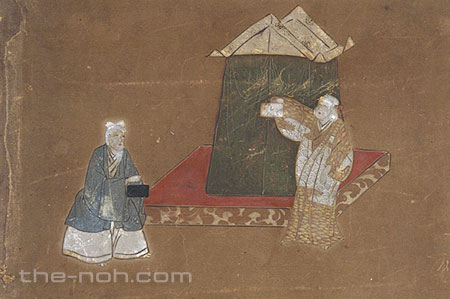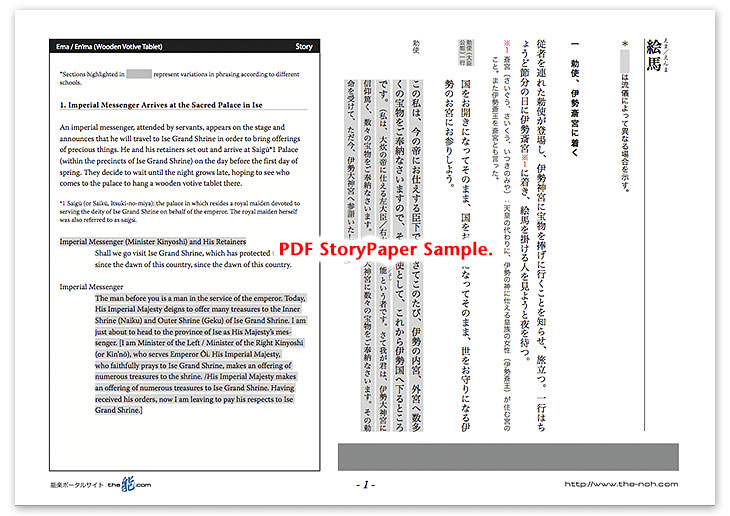
 Ema/En’ma
Ema/En’ma

![]()
Around the end of the year, the emperor (Emperor Ōi) sent an imperial messenger with offerings of treasures to Ise Grand Shrine. The messenger arrives at Saigū Palace in Ise*. The messenger hears about a ritual on New Year’s Eve (the day preceding the first day of spring, according to the lunar calendar), on which a wooden votive tablet will be hung up and displayed. He therefore decides to witness the ritual before going back to Kyoto. When the night grows late, an old man and old woman come to pray at the shrine. The old man has a wooden votive tablet on which a white horse is painted, and the old woman has one on which a black horse is painted. These paintings of horses predict the weather; the white horse means it will be sunny while the black horse means it will rain. The tablet displayed at the shrine at the end of the year predicts the weather of the next year. Every year, either a tablet with a white horse or a black horse is put on display. The two of them insist upon hanging up the tablet he or she is holding: “This year, let’s offer this white horse tablet.” “We shall offer this one with a black horse.” The old man and old woman argue with one another. In the end, however, they hang both tablets side by side. They decide to pray for both sunny days and rainy days so that people can enjoy well-balanced weather. The old man and old woman reveal that they are the two gods of Ise (two gods serving to the two principal gods of Ise) who have transformed themselves into this couple. They tell the messenger to look for them at dawn and then disappear into the darkness.
The male god and female god (or two celestial maidens) appear before the messenger, and then Amaterasu Ōmikami, the Sun Goddess, makes an appearance. The three of them perform a dance depicting the scene of Amano Iwato in mythology (the legend that Amaterasu Ōmikami hid in a cave behind a massive rock door). The gods laud the prosperity of the nation.
*Saigū (or Saikū, Itsuki-no-miya): It is the palace in which resides a royal maiden devoted to serving the deity of Ise Grand Shrine on behalf of the emperor (Ise no Saiō). The royal maiden herself was also referred to as saigū..
![]()
In olden days in Japan, the first day of spring was considered to be the first day of the new year. Therefore, Setsubun (the day preceding the first day of spring) was New Year’s Eve. In the palace of a sacred royal maiden serving at Ise Shrine, there was a building in which to hang up and display wooden votive tablets (Ema-den or Ema-dō, the Hall of Wooden Votive Tablets). Every New Year’s Eve, a votive tablet was secretly hung up in that hall. People predicted the weather of the coming year by the picture on the tablets. If the tablet hung up on display had a white horse on it, they expected the new year to have more sunny days, while if it had a black horse on it, they expected more rainy days. People believed that this wooden votive tablet was put on display by divine will. This play, Ema (Wooden Votive Tablet), which describes this ancient ritual of hanging up and displaying a wooden votive tablet, includes the very special episode of “Amano Iwato” (the mythological episode in which the Sun Goddess, Amaterasu Ōmikami, hides in a cave), and prays for the peace and security of the nation.
A prop of a palace is placed on the stage and used for different purposes in the first and second halves. In the awe-inspiring atmosphere of Kami-Noh (Noh Featuring the Gods) created by the calm and invigorating chants, the palace and its closed door exudes divine presence. In the first half, the old couple suddenly appear out of the darkness and hang up the wooden votive tablets of white and black horses. In the second half, the prop is used to describe the scene in which Amaterasu Ōmikami hides herself behind a rock door and then makes her appearance. Interesting scenes are created in and outside of the prop of the palace. The audience will feel that they have traveled back in time and are witnessing the mysterious ritual of hanging up the wooden tablet as well as a moment in the mythic realm of the gods. Through this play, we can experience the unsophisticated, sincere beliefs that the Japanese people have held since ancient times.
The scene of “Amano Iwato Kakure” in the second half differs considerably according to the school. Comparing these differences is one way of enjoying this play.
STORY PAPER : Ema/En’ma
Story Paper presents noh chant stories in modern speech, with story outlines, highlights and more using Adobe PDF format, which can print out and zoom in. Print out the pages and take them with you when you see the actual noh performance.

The copyright of Story Paper is held by the Noh.com. Story Paper is for individual use only. It is prohibited by the copyright law to distribute or publish printed-out Story Paper pages without prior consent. For more information, check the credit and disclaimer pages.



 [Ema/En’ma : Story Paper PDF : 553KB
[Ema/En’ma : Story Paper PDF : 553KB